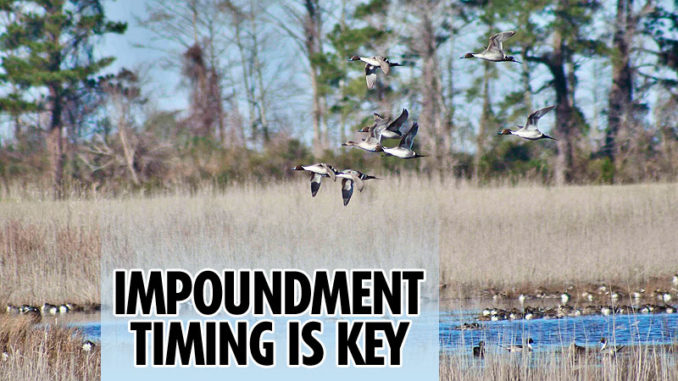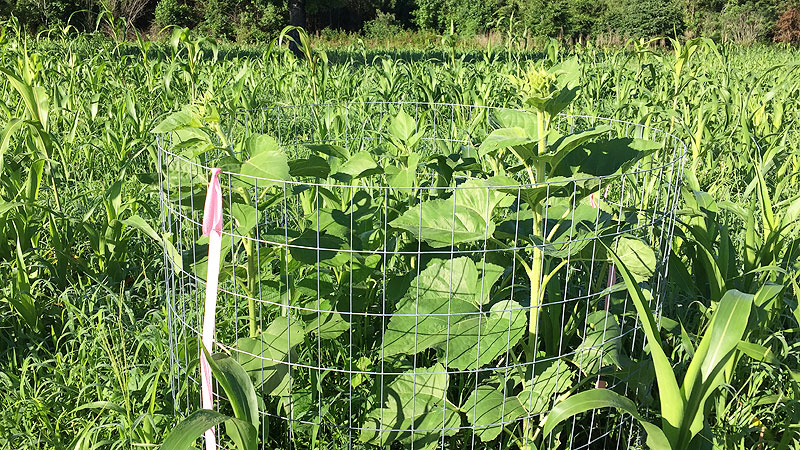
Planting for waterfowl must be on calendar
As March arrives, the dogwoods are blooming and the countryside is looking greener every day. No doubt, spring is here, and planting activities will begin very soon, depending on landowner goals. Timing is indeed everything. Landowners must decide when they want their efforts to be realized the most.
Landowner goals can vary tremendously by species of wildlife and season of availability. Looking for a sustainable nutrition program? A program to provide food for wildlife every month of the year is undeniably the best approach for total management. But, this rarely happens. Most landowner planting goals and maturity dates are specific to one hunting season, and that is okay. But the schedule is still important to make sure food becomes available at the right time and for the intended consumers.
Know your goals before planting
Before planting the first seed, landowners or land managers must examine their goals and make sure they are on a schedule that will meet or exceed their expectations for their wildlife’s needs.
When is the perfect time to plant a food plot or waterfowl impoundment? That depends on the intended crop, air temperatures, soil temperatures, maturation period and the anticipated period of availability. And then, it really depends on the targeted wildlife species.
On a broad sense, most land managers invest time and dollars in plantings for the benefit of one of three species: waterfowl, wild turkey or whitetail deer. While one is the intended target for most plantings, non-target species of wildlife such as rabbits, squirrels, dove, and quail will benefit from food-production efforts.
Food plots planted for deer and turkeys have a fairly specific maturity time interval and can vary some without any detrimental effects. But the timing for duck plantings is a critical part of the game. If a fall or spring food plot ends up being a little early or late for the deer, it’s nowhere close to the major mistake of mistiming a crop in an impoundment. The maturation window for duck impoundments is vital to a good season.
Timing matters
Waterfowl plantings are always followed up with seasonal flooding to provide ducks with food in a flooded environment. The timing of plantings for waterfowl impoundments are less of a moving target than deer plots because of the annual migration of migratory species into the Carolinas during the fall and winter. Migrating waterfowl begin arriving in September. They will continue to show up until after the end of the year. But migrating flocks don’t have to stay around when they pass through. Ducks must find something they like or need. They need something to make them stay, such as a rich, protected food source.
Landowners with waterfowl in mind must flood impoundments and have a mature crop of tasty energy morsels ready for immediate consumption to give arriving birds something to delay their southerly trajectory. Planting impoundments too early can also be detrimental to food availability when it is needed the most.
Duck impoundments can be planted with a wide variety of crops, including millet, sorghum, buckwheat, chufa, rice and corn. When flooded and mature, ducks will happily feast on any of these. But they aren’t the only wildlife species that will readily gobble up these tasty crops when mature. Deer, turkeys, songbirds, wild boar and resident geese can decimate these crops long before the migrating ducks ever arrive.

Most waterfowl impoundments are typically small because of the in-depth efforts to enable water retention. A herd of deer can eliminate an entire crop if left mature for too long before flooding, and flooding doesn’t eliminate browsing, either. A flock of Canada geese can strip a flooded field quickly, leaving nothing remaining for the ducks en-route from Canada.
Work backwards
The way to formulate a plan for impoundments begins with the end in mind. The anticipated flood date is the benchmark to work from, and activities are scheduled in reverse order.
When is the best flood date for impoundments in the Carolinas? The answer isn’t clear cut. It can vary depending on when hunters want to start shooting ducks; that, in turn, will begin the attrition process.
Early teal seasons arrive in September, followed by short seasons in October and November. The bulk of the season, about 40 days, opens in December. The migrations begin in September and peak from late November through December.
Hunters need to decide if they want to hunt the early seasons, potentially sacrificing food availability during the last month when winter weather arrives. The best option would be to plant 500 acres of corn. At that rate, impoundments could be flooded in September, and ducks would never run out of food. But planting a large volume of crops that isn’t going to produce financial returns is not feasible for 99 percent of hunters. Most impoundments are significantly smaller, and food availability will be limited. The flooding date is a critical benchmark that landowners need to set and work back from.
Give crops the proper time to mature
Crop shrinkage after maturity isn’t the only controlling factor either. Crops must have time to fully mature and dry out before cold weather arrives. An early October freeze can cripple crops that haven’t fully matured. Additionally, most duck impoundment crops flourish from a combination of long, hot days and abundant summer showers that will produce high yields.
In the Carolinas, most impoundments are typically flooded in mid-October to ensure incoming ducks have a place to go and to accommodate the October and November duck seasons. But land managers with smaller fields could shift the flood date to Nov. 1 in hopes of extending food availability without sacrificing the November migration window.
Landowners need to allow for at least two weeks of drying before flooding, and planting dates can be established depending on the maturation window specified on the crop label.
Planting too early may produce a wonderful crop but can be worthless because of the heavy browsing it will receive from other wildlife. For the best results, landowners planting duck impoundments should always work backwards with the end in mind.
Essential plant nutrients: Hydrogen often overlooked
Hydrogen isn’t one of the typical, essential plant nutrients most growers are accustomed to discussing or adjusting. However, it is a major, contributing factor to the fate of all plants and animals. Hydrogen is one of the 18 essential plant nutrients required for survival, but it is typically obtained through the atmosphere through photosynthesis or absorbed through the soil from one of the many compounds containing elemental hydrogen, like water itself.
Plants split water molecules through photosynthesis to create energy, while producing hydrogen ions and oxygen as byproducts. In addition, hydrogen ions come from a variety of other sources, including decaying organic matter, root respiration and other chemical/biological mechanisms.
 All organic molecules in plants contain hydrogen. One of the most-important organic plant molecules is glucose, which is sugar that is made up of hydrogen, oxygen and carbon elements. When plants consume glucose, the hydrogen gets converted into other biomolecules such as: DNA, RNA, fats and carbohydrates.
All organic molecules in plants contain hydrogen. One of the most-important organic plant molecules is glucose, which is sugar that is made up of hydrogen, oxygen and carbon elements. When plants consume glucose, the hydrogen gets converted into other biomolecules such as: DNA, RNA, fats and carbohydrates.
The availability of attachable hydrogen ions also controls the acidity of soils or the environment where metabolic and chemical processes happen. Soil acidity is controlled by the level of attachable hydrogen ions. Essentially, the more hydrogen ions in the soil, the more acidic the soil is.
Farmers can’t really control the level of hydrogen in plants, but it is important to understand that hydrogen is one of the most-important plant nutrients there is and it participates in every aspect of the plant’s biological and chemical needs.
Hydrogen makes up 15 percent of the elemental volume found on earth. And in the universe, over 90 percent of all available elements are hydrogen atoms. That’s a lot of hydrogen, right?




